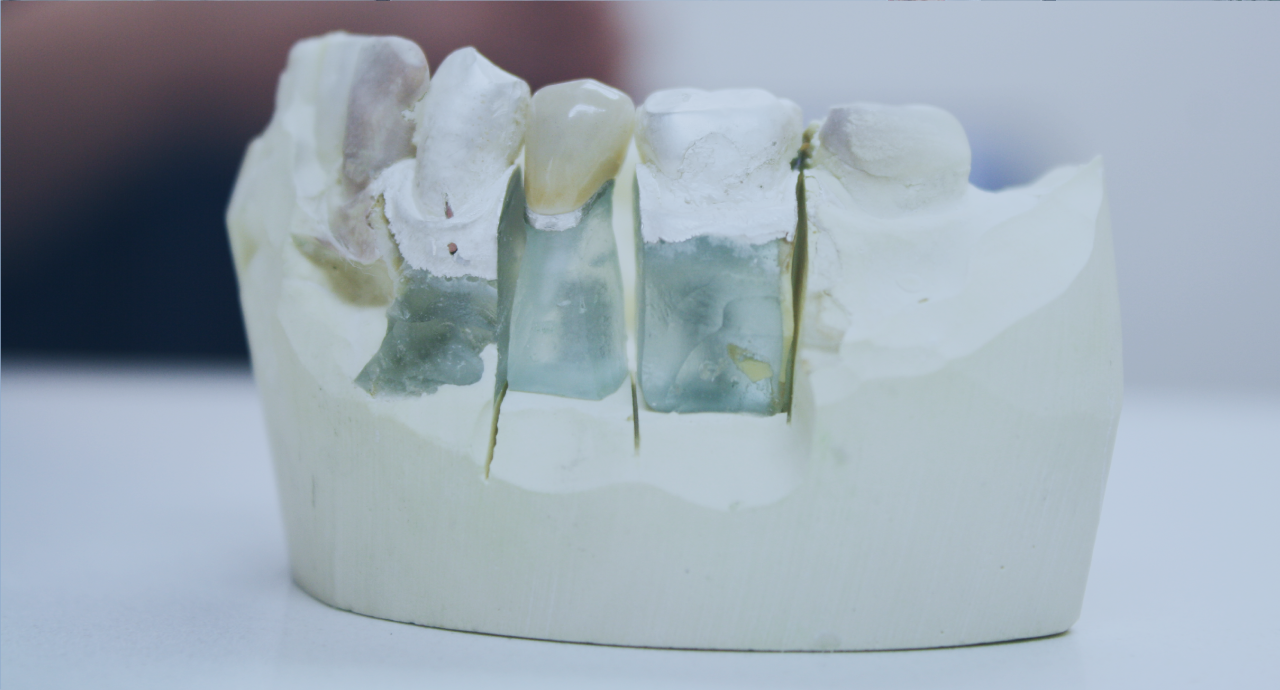
A Crown is a tooth restoration which covers the entire tooth. Teeth can require restoration for many different reasons. When people are younger they are more prone to decay; decay in teeth is removed and usually replaced with some type of filling material. This can be done because the area of decay is normally a small or moderate sized hole inside a tooth. As time goes by, these fillings require replacing and there is less tooth remaining. In addition to this, teeth can crack or fracture as well as suffer more significant injuries. Eventually, there is not enough tooth left to hold a filling, so a crown can be made to fit over the remaining portion of the tooth. These crowns are made of ceramic or gold alloys. These are constructed at very high temperatures, and therefore are made outside the mouth in a dental laboratory. To allow us to make crowns outside the mouth, we use either impressions or digital impressions. This type of dentistry is called Indirect Dentistry. This simply means that the restorations are made outside of the mouth rather than inside the mouth as with a typical filling.
What is the process for getting a crown?
Examination and Consultation
Firstly, the tooth will need to be assessed to make sure that it is suitable for a crown, and secondly, that a crown is the correct course of action for the damaged tooth.
Some teeth are not too badly broken and can be restored with fillings, and other teeth have too little of the tooth remaining and may end up being extracted. A Prosthodontist would normally assess all of your teeth and the surrounding gums and jawbones to make sure that the crown will last for a very long time. This assessment would also be used to determine what type of material to make the crown out of as well as what colour and shape.
The Procedure
Preparation
A crown preparation appointment involves local anaesthesia, tooth preparation, final crown and bridge impression taking, bite recording, and construction and placement of a temporary crown.
A crown is like a sleeve fitting over the tooth. It needs to have a certain thickness if it is to withstand chewing forces for a long period of time. The usual thickness required is approximately 1 or 2 mm. This needs to be removed from the tooth in a quite specific way so that the crown will not fall off or fracture for a long time. This is usually carried out using local anaesthetic injection with a dental drill. While the crown is being constructed, a temporary crown is used over the tooth which is approximately the same shape and size as the final crown. Temporary crowns are not as strong as final crowns and care should be taken with these.
Placing the crown
Once the crown is constructed, it is placed on the tooth. The temporary crown is removed along with the temporary cement. The crown is checked to make sure that it is the right shape, colour, and size. The bite or occlusion is very important. If the crown is left higher than the other teeth, the muscles in the jaw will very quickly fracture either the crown or damage the tooth underneath.
For crowns that replace front teeth in an aesthetic area, we always place these on a temporary basis so that people get a chance to go home and check over several weeks that they are completely satisfied with the colour and shape. The dental laboratory we use is in the rooms next to our office, so colours and shapes can be changed very quickly– usually within one hour. The final crown is not cemented permanently until at least 1 month has elapsed with the crown in temporarily which will give someone enough time to decide if they are happy with the result.
We encourage opinions from other people as well as photographs be taken to make sure the final crown is correct in all situations. Using this technique, it is possible to match the colour and shape of teeth exactly.
Care
After preparation
Usually following tooth preparation, there is discomfort caused by the drilling process as well as opening wide for 30 or 40 minutes. We encourage people to use Panadol or Nurofen before the local anaesthetic has completely worn off. Another mild analgesic before bed is usually enough to resolve most problems. The usual symptoms experienced following crown preparation appointments are mild to moderate discomfort at most.
After crown placement
The care required for a crown is similar to that for natural teeth. Dental floss or using brushes to clean between teeth is an excellent way to maintain your teeth and crowns in the long term. Common sense should prevail in the types of food eaten. Biting fingernails or similar small objects will increase the risk of fracture of teeth and crowns. In the past, aesthetics ceramic crowns have had a higher risk of fracture due to the developmental nature of some of the ceramics. Current ceramics are extremely hard and difficult to break. The risk of fracture of these restorations is now quite small, however it is still present. Crowns can fracture in a similar way to teeth. Any incident which could break a tooth could break your new crown. The incidence of fracture these days is minimal. We would see a fractured crown approximately once every 1 or 2 years.


